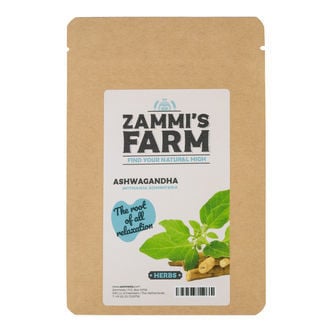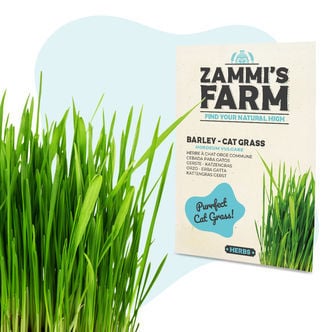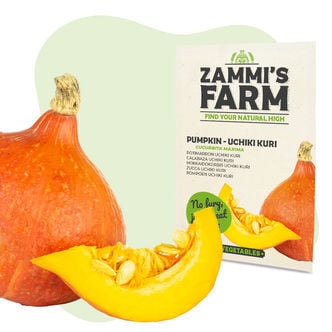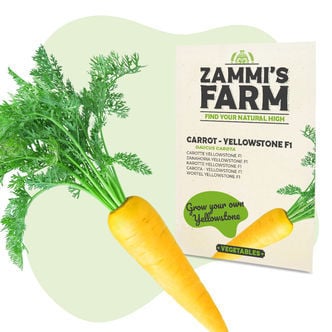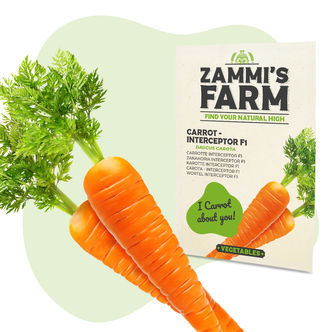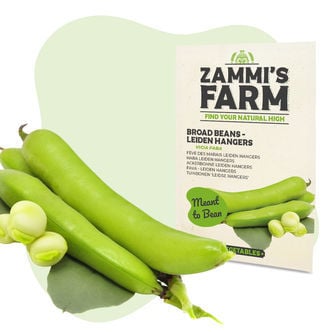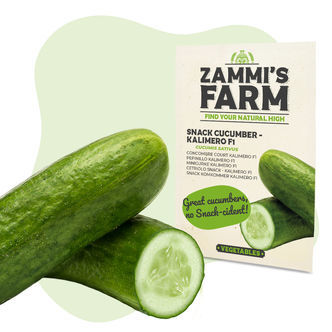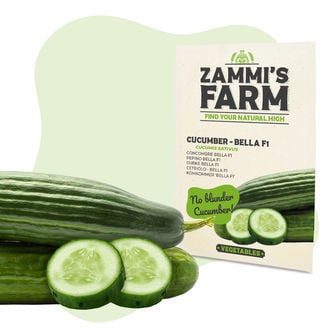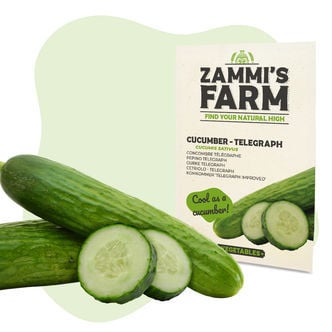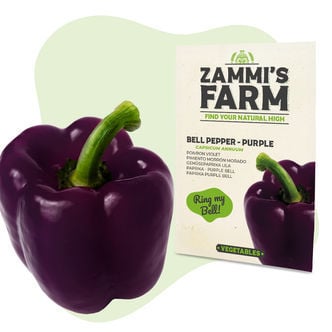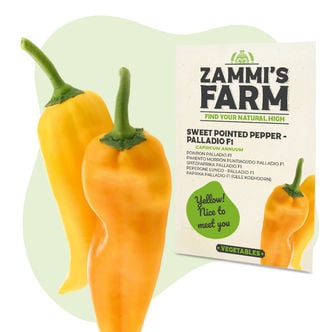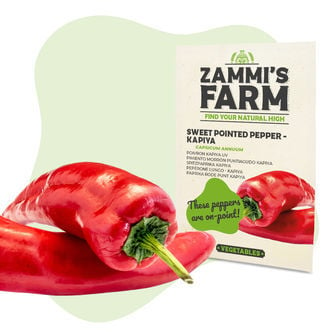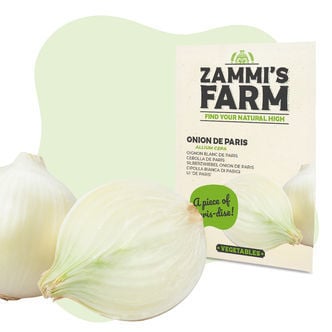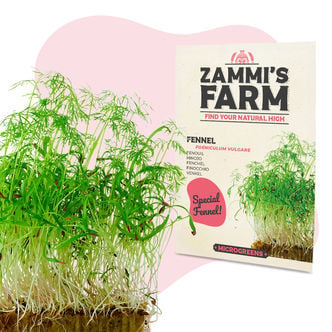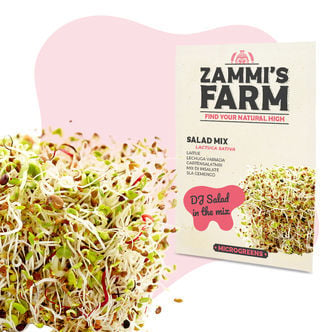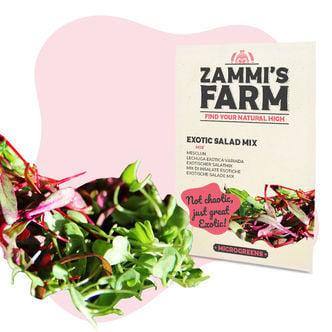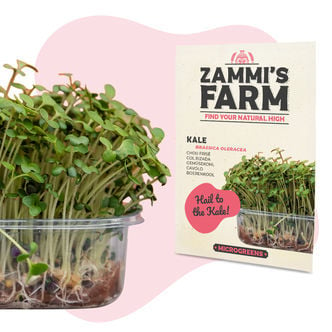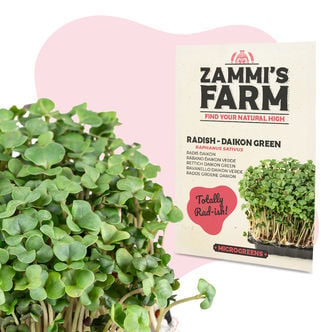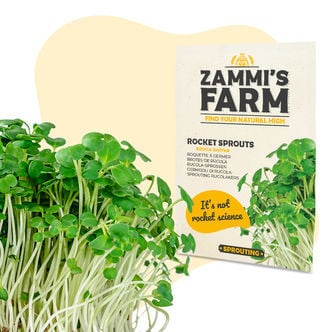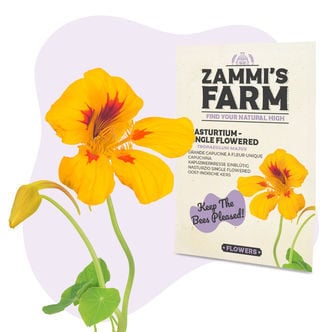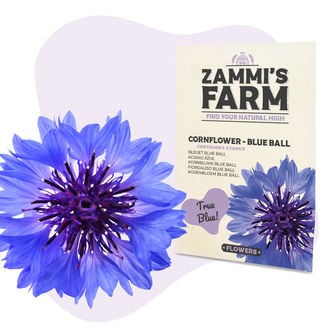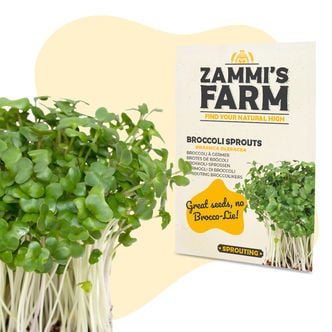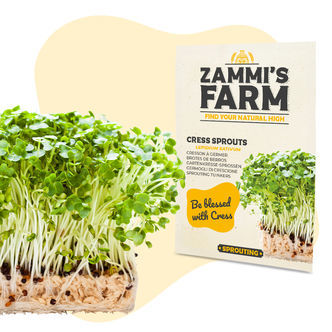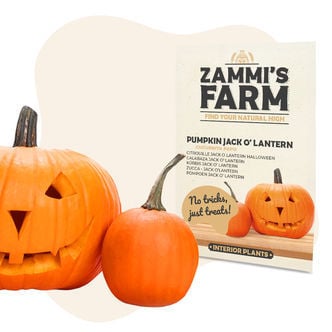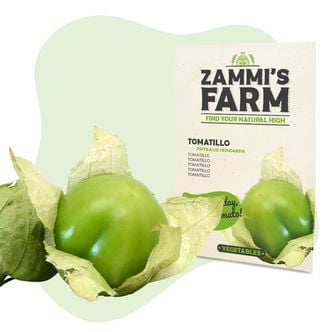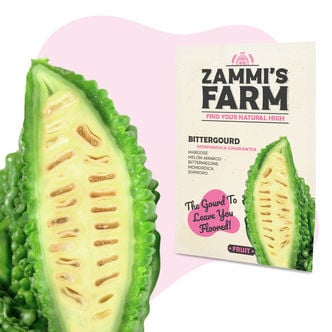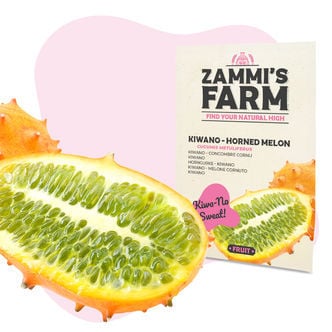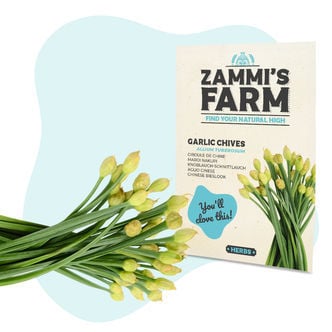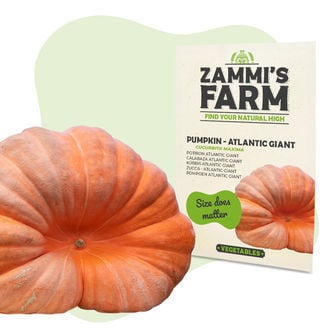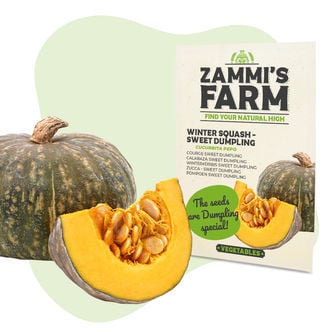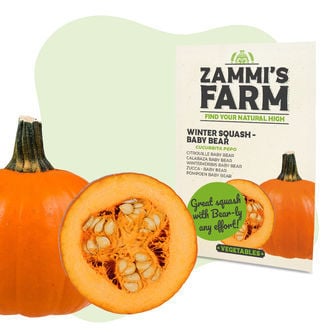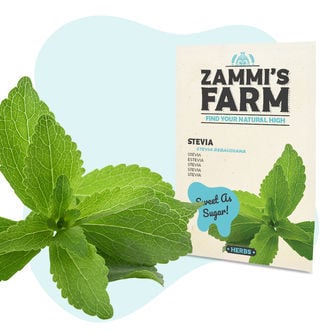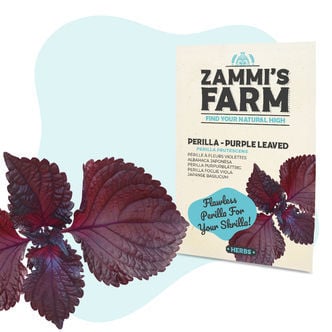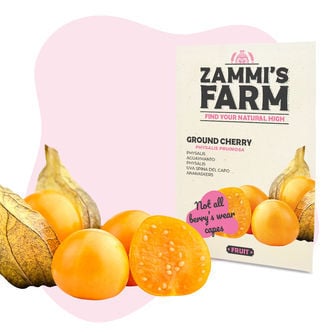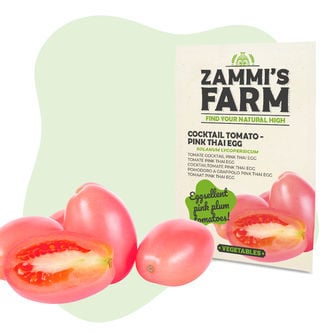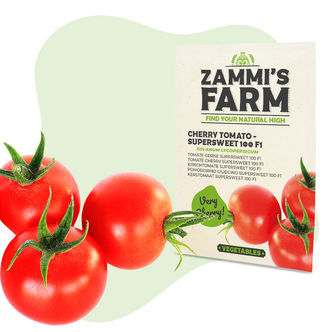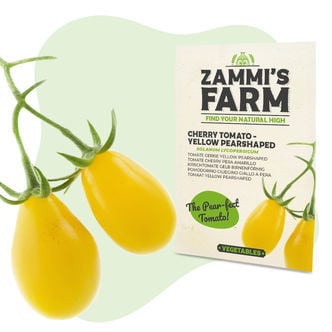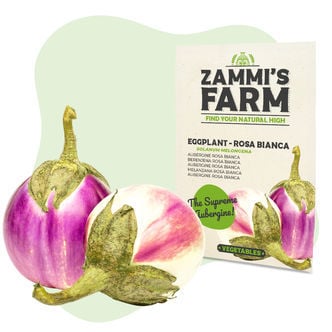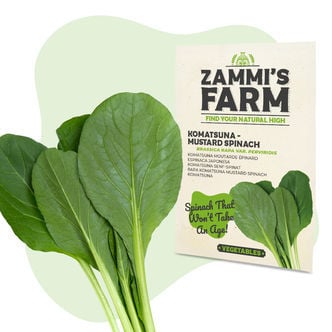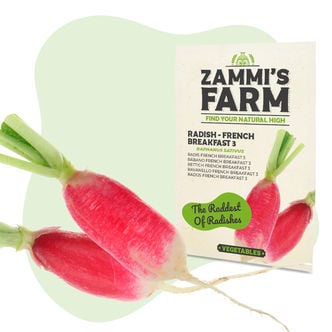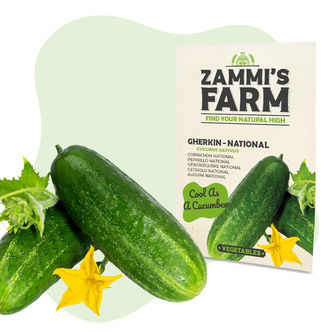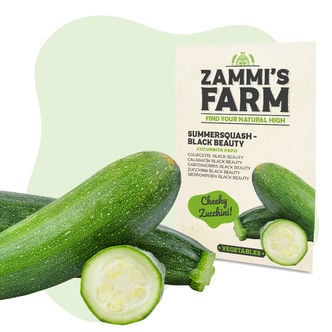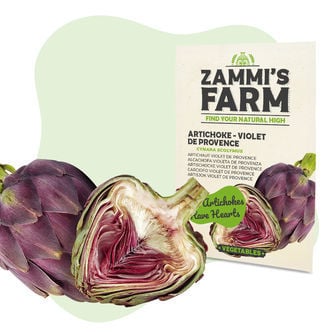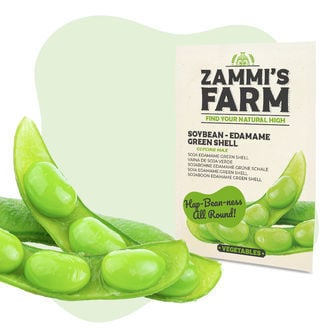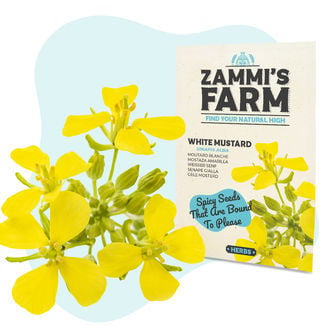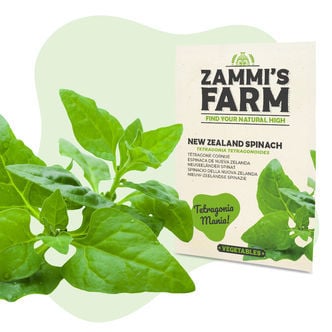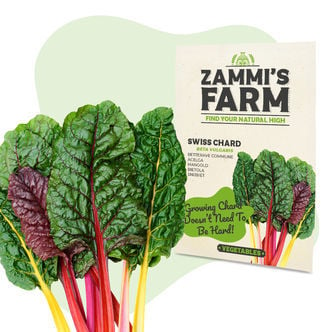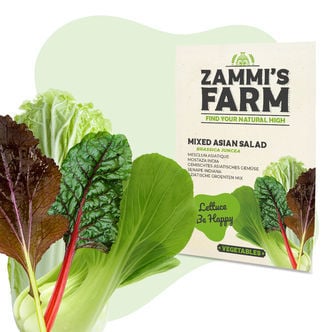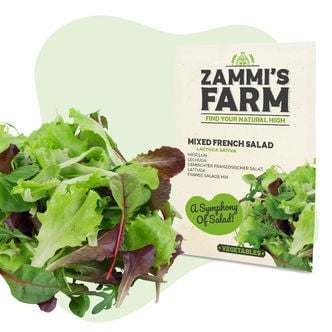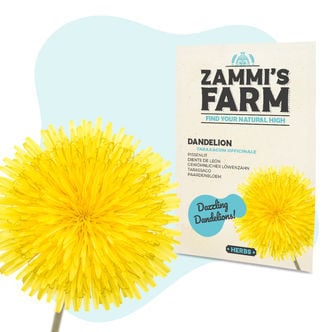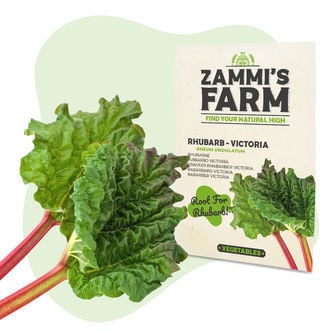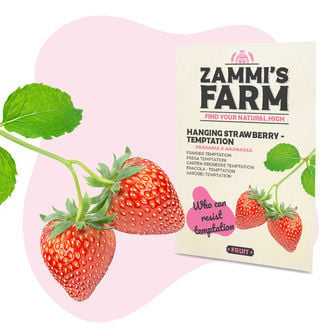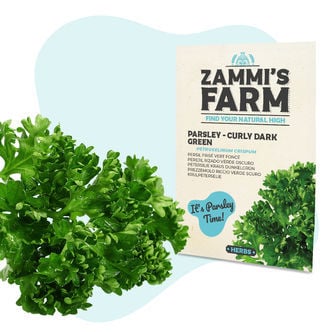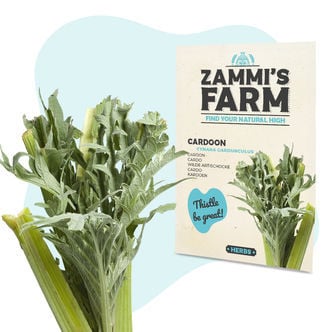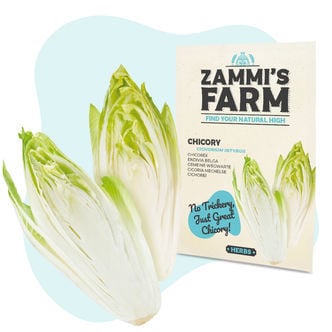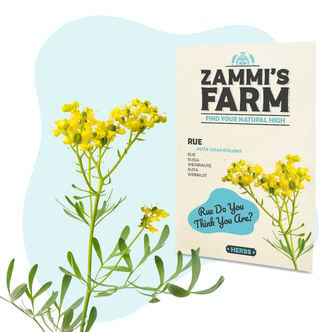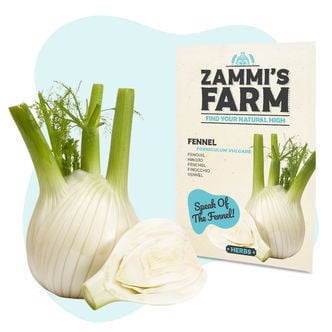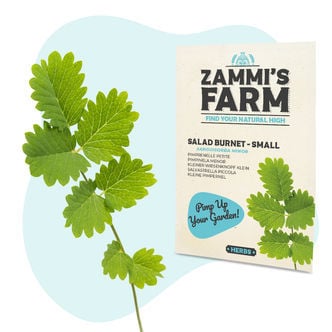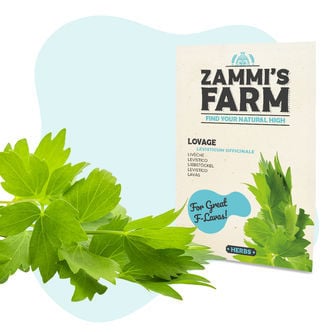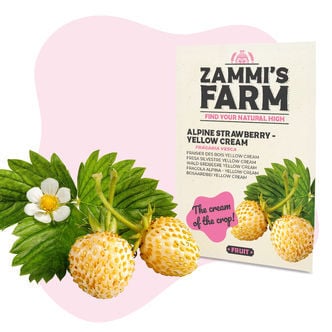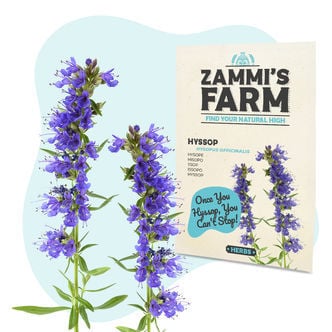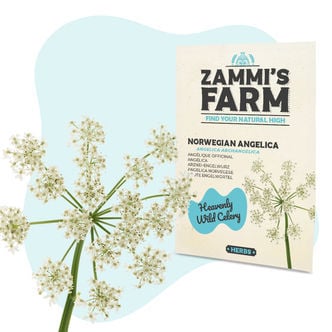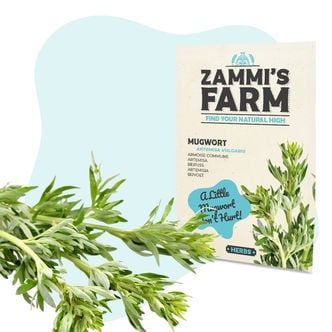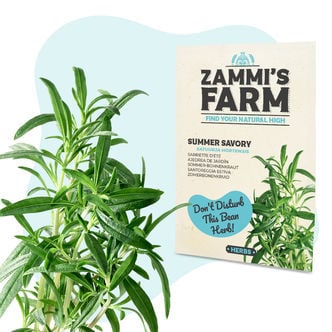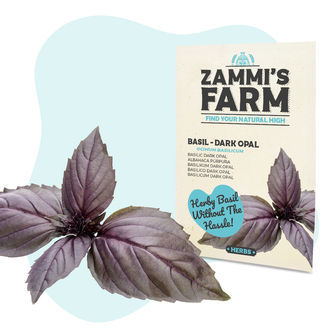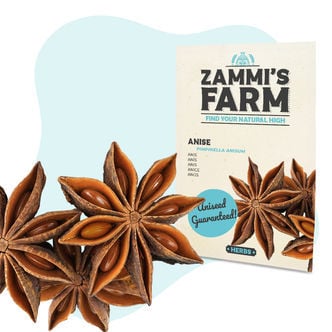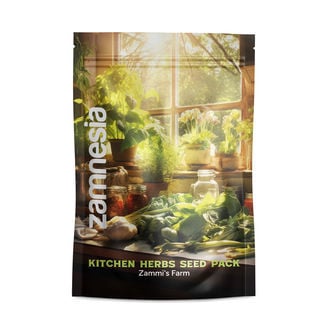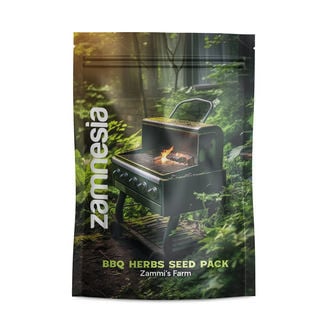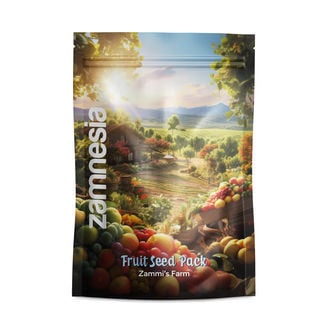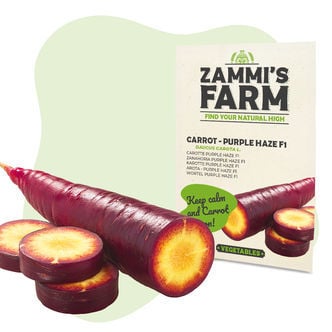Edible Plant Seeds
There are 116 products.From fruits and vegetables to herbs and spices—there's no shortage of edible plants you can grow at home. At Zamnesia, we now stock a wide variety of edible plant seeds for hobby gardeners and food farmers. From everyday favourites like Alpine Strawberries to unique cultivars like Dark Opal Basil and Lemon Apple Cucumbers, we consistently stock exciting edible plant varieties for your garden. Browse our selection below, and remember; Zamnesia edible plant seeds are specially selected for quality and maximum germination rates.
Ashwagandha (Withania somnifera) Seeds
Ashwagandha (Withania somnifera) is a shrub native to India, and it has been used for many years in the Ayurvedic tradition. Attractive and easy to cultivate, why not try growing it in your very own garden?
Barley - Cat Grass (Hordeum vulgare) Seeds
Barley - Cat Grass (Hordeum vulgare) Seeds are, as the name suggests, purrfect for your cat. It works as a digestive aid for them and may also prevent hairballs! The plant is effortless to grow and care for and can be sown between the months of April and September. Pick a light spot for them to flourish in, but ensure it doesn't get too much direct sunlight. This is one fast plant to grow!
Pumpkin Uchiki Kuri (Cucurbita maxima) Seeds
Uchiki Kuri, also known as Red Kuri, is a bright orange squash variety. Seeds can be sown in spring outdoors directly in seed beds. Mature plants like rich organic soil, so prepare the soil with compost or manure or fertilize regularly. Besides being very decorative, Uchiki Kuri squash boasts sweet flesh that goes great in sweet and savoury recipes.
Yellowstone F1 Carrot (Daucus carota) Seeds
Add some bright yellow magic to your garden with these Yellowstone F1 Carrot (Daucus carota) Seeds. Simply sow these seeds directly into the ground in March and keep the soil moist throughout their growing cycle. When August rolls around, you'll be met with a whole bunch of yellow carrots that are perfect for a wide variety of dishes and meals. What could be better than that?
Carrot - Interceptor F1 (Daucus carota) Seeds
These slimline carrots make for a healthy snack and have a sweet, satisfying taste. What's more, is that these seeds are effortless to cultivate and are unlikely to give even the most novice of growers a hard time. Sow these seeds directly into the ground and provide them with a little maintenance and upkeep and they'll deliver a bevvy of bright orange beauties come July-October. Perfect.
Broad Bean Leidse Hangers (Vicia faba) Seeds
Broad beans are not only delicious but also super healthy. This fast-growing and resistant variety can be planted in early spring or fall and produce plentiful harvests of long, sweet beans filled with 5-6 pods. Blanched, stir-fried, or in soups and stews, these delicious beans make a great addition to a variety of meals. Plus, they can also be frozen fresh and keep for months in the freezer.
Kalimero F1 Snack Cucumber (Cucumis sativus) Seeds
Whether pickled, as part of a salad or just a healthy treat, our Kalimero F1 Snack Cucumber is an incredibly simple veg to cultivate, not to mention extremely fast too! Get them going indoors around March and bring them outside for them to flourish over Summer. They're so quick to grow that you can actually get a few harvests from the same plant at the end of Summer. Versatile and accessible!
Cucumber Bella F1 (Cucumis sativus) Seeds
Bella F1 cucumber seeds (Cucumis sativus) produce long, sweet, and crisp fruit and are resistant to mildew. Start seeds outdoors in early-mid Spring and remember to water your plants generously while taking care not to wet their leaves (which attracts moulds and other pathogens). Use trellises to support the long vines and save space, and enjoy continuous harvest all throughout summer.
Telegraph Cucumber (Cucumis sativus) Seeds
There's nothing quite like the refreshing flavours of cucumbers. Whether added to salads or as a snack, Telegraph Cucumber (Cucumis sativus) is one versatile veg. Get these seeds started under glass from mid-March, provide some maintenance and upkeep, and come Summer, you'll have plenty of cucumbers to get your fill of. Leave around 40cm between plants and provide moist soil, and you're golden.
Paprika Purple Bell (Capsicum annuum) Seeds
Add some vibrant violet colours to your garden! Paprika Purple Bell is the way to go. Get these seeds sown and started under glass between March and May, and you'll be greeted with a bevvy of purple peppers come summertime. Just house them in moist soil with a consistent temperature of around 20-25°C; you can't go wrong. With sweet flavours, they make the perfect addition to all kinds of dishes.
Sweet Pointed Pepper Palladio F1 (Capsicum annuum) Seeds
Get these bright yellow beauties going from mid-March, and give them plenty of light, sun and moist soil, and they'll flawlessly perform. These sweet and mild peppers will be ready come late Summer. They require very little in the way of maintenance and are extremely versatile. Whether you add them to salad, tacos or any other savoury dish, these yellow peppers are sure to brighten your plate.
Sweet Pointed Pepper Kapiya (Capsicum annuum) Seeds
Looking for something genuinely vibrant both in colour and flavour? Allow us to introduce the Sweet Pointed Pepper Kapiya. It's believed this pepper is originally from Bulgaria but has been used widely throughout Europe and the rest of the world. Sow these seeds in early Spring and repot as soon as the first leaves appear. Move the plants outside and let them flourish until October.
Onion de Paris (Allium cepa) Seeds
How do you get your hands on some great-tasting onions? Easy, simply sow these seeds in early Spring under glass and then move them outside in late April. This will give them plenty of time over the summer to mature and be ready for the picking! These onions are perfect for pickling or including as tiny veg on your plate or as part of a summer salad. The options are plentiful, and so is the yield!
Microgreens Fennel (Foeniculum vulgare) Seeds
Peppery, mild and sweet, Microgreens Fennel takes just 7-14 days to germinate and just another 2 weeks on top until the earliest greens are ready to harvest and use in a multitude of dishes. Just provide them with plenty of light and warmth and keep the surrounding soil moist, and you simply can't go wrong! This is one fast-to-grow plant that delivers in all areas. Get some in your home today!
Microgreens Salad Mix (Lactuca sativa) Seeds
With a selection of great greens available here, the vibrant Microgreens Salad Mix is ideal for adding to salads and can actually be grown all year round. Quick to flourish, sow the seeds when it works for you; just be sure to keep the soil moist but not waterlogged, and this plant will deliver delicious, moreish leaves and work perfectly in plenty of dishes. Ideal for all growers!
Microgreens Exotic Salad Mix - Seeds
Take your salad game to the new level with Exotic Salad Mix. It's really easy, just scatter the seeds on top of the soil and press gently. Cover with a thin layer of soil and spray with water. Use the mister once or twice a day to keep soil most. Harvest after 2–3 weeks, when you see the first set of true leaves. Microgreens thrive in sunny environments, think windowsills or balconies.
Microgreens Kale (Brassica oleracea) Seeds
Kale (Brassica oleracea) is in the spotlight for being one of the most nutritious greens on the market. But did you know that kale sprouts are even more packed with nutrients than fully mature kale plants? Sow kale seeds in a propagator at high density, and harvest your sprouts after 7–10 days for a fresh, delicious, and highly nutritious microgreen.
Microgreens Radish - Daikon Green (Raphanus sativus) Seeds
Green Daikon Radish is delicious and highly nutritious, used typically as a garnish in Japanese cuisine. Daikon Green Microgreens, however, are just as packed with flavor yet with much higher nutrient density. To grow them, simply sow seeds at a high density in a propagator and harvest the sprouts after roughly 1 week. With a fresh, tangy flavour, they go great in fresh and cooked Asian dishes.
Rocket Sprouts (Eruca sativa) Seeds
The peppery leaves of Rocket Sprouts make for the ideal addition to a wide variety of dishes; what's more, is that the path to this tasty produce is an extremely easy one, regardless of your prior expertise! Rocket Sprouts can be grown in indoor, outside, and greenhouse settings and require very little in the way of maintenance. Sow seeds in early Spring and enjoy great flavours come Summer.
Nasturtium 'Single Flowered' (Tropaeolum majus) Seeds
Boasting deep red, orange, and yellow hues, nasturtium flowers are surrounded by rich green leaves, making for a visually appealing plant. Able to reach heights of around 3m, this climbing plant is ideal for walled gardens and spacious areas. Not only boasting great looks, the flowers are also edible, making a vibrant addition to various dishes.
Cornflower 'Blue Ball' (Centaurea cyanus) Seeds
The Blue Ball cornflower is a great-looking flower that's ideal for a whole host of gardening set-ups. Sow the seeds directly into the ground in a place of your choosing in late spring, and they'll mostly take care of themselves throughout the summer. Without much needed in the way of maintenance, these flowers undoubtedly appeal to all levels of expertise. Colourful and vibrant, perfect for all.
Broccoli Sprouts (Brassica oleracea) Seeds
Whether you like them in your smoothie, salad or sandwich, there's no denying the rich antioxidants and tasty flavours of Broccoli Sprouts. They're also incredibly simple to cultivate. Sow the seeds in a pot in early Spring and give them plenty of sun, warmth and a little water now and again, and they'll flourish effortlessly. Come August, they'll be ready to harvest and can be enjoyed instantly.
Cress Sprouts (Lepidium sativum) Seeds
Cress Sprouts make for an easygoing and hugely rewarding growing project. Whether situated on a windowsill or as part of your garden, it'll perform with very little maintenance required. This is a fast-growing plant that can be sown and grown all year round. Just be sure to provide temperatures of around 20-22°C and a little upkeep, and you can enjoy tasty cress rich in vitamins A, B and C.
Cornflower 'Mixed' (Centaurea cyanus) Seeds
With an abundance of purple, blue, pink, and white hues, the cornflower (Centaurea cyanus) is one of the best options for brightening up your garden. Pleasing to the eye but overall undemanding, these plants will appeal to gardeners of all skill levels. Whether planted in borders or as wildflowers, these flowers will attract bees and other beneficial insects to your garden.
Pumpkin Jack O' Lantern (Cucurbita pepo) Seeds
Bred especially to be carved into Jack O' Lanterns, this beautiful orange, oblong Cucurbita pepo variety produces pumpkins that are very decorative yet still tasty, too. Sow your Jack O' Lantern seeds indoors in late winter, or directly outside in early spring. Like other pumpkin varieties, Jack O' Lanterns are best grown in fertile soil with stakes or trellises to accommodate their long vines.
Tomatillo (Physalis ixocarpa) Seeds
The Tomatillo or Mexican Husk Tomato dates back to the pre-Columbian era. It produces a spherical fruit with a green/purplish colour that looks similar to tomatoes but has a different flavour and texture. Tomatillo seeds are best sown indoors, and plants can be brought outside in Spring after the last frost. Tomatillo plants like well-draining soil, full sun, and regular organic fertilisation.
Bitter Gourd (Momordica charantia) Seeds
The bitter gourd, otherwise known as bitter melon or balsam pear, is a fruit that originally comes from Africa and Asia. However, now you can grow it right at home! Start it off in a greenhouse or indoors for 4 weeks, then move it outdoors to flourish in the summer months. Typically, it'll be ready to harvest come October. Pair it with fish or meat, and you simply can't go wrong.
Horned Melon (Cucumis metuliferus) Seeds
Looks can be deceiving with this prickly fruit. It might look a little intimidating, but it's what's inside that counts. The Kiwano houses a sweet taste that's reminiscent of lemons and bananas. Perfect for fruit salads and desserts. Start your plants out in a greenhouse and then place them outside for full sun. A little hands-on grow-wise but manageable, it needs a warm climate or location.
Garlic Chives (Allium tuberosum) Seeds
Also referred to as Chinese chives and oriental garlic, garlic chives are a tasty herb with flavours reminiscent of its namesake. It's used in a wide variety of dishes, such as fish, salads, and soups. Before using them, though, you'll need to grow them! An easy affair, you can grow garlic chives both indoors and outdoors. Just give them moist soil and regular light, and watch them thrive.
Atlantic Giant Pumpkin (Cucurbita maxima) Seeds
Try your hand at growing Atlantic Giant Pumpkin which can weigh 100kg and more. This vegetable thrives in warm and sunny spots, and you can sow your seeds indoors in mid-spring or early summer outdoors. Ensure your plants have fertile soil and are sheltered from cold winds and you will be able to sit back and watch this vigorous grower. Harvest in September/October, right for Halloween!
Winter Squash Sweet Dumpling (Cucurbita pepo) Seeds
Sweet Dumpling is a delicious variety of winter squash (Cucurbita pepo) with a hard, cream-coloured rind and tender, sweet flesh. Growing to roughly the size of a grapefruit, Sweet Dumpling squash make a great addition to any veggie patch. Start seedlings off indoor in late winter or directly outdoors in early spring. Like other squashes, plant Sweet Dumpling squash in highly fertile soil.
Winter Squash Baby Bear (Cucurbita maxima) Seeds
Baby Bear Winter Squash (Cucurbita maxima) is a must-have for every veggie patch. Germinate your seeds indoors and bring them outside in the spring. Plant Baby Bear squash in soil with plenty of manure or compost to ensure healthy growth and the production of large, sweet fruit. Use tutors, stakes, or trellises to grow Baby Bear Squash vertically in smaller spaces.
Stevia (Stevia rebaudiana) Seeds
Stevia rebaudiana or sugarleaf is very easy to grow. Germinate seeds indoors and bring them outside in mid-summer. Plant stevia in full sun in well-draining soil with a pH of 6.7-7.2. Feed plants regularly with a natural liquid fertilizer or nitrogen-rich organic fertilizers like compost, worm castings, guano, or something similar to fuel healthy leaf growth. Use stevia as a natural sweetener.
Purple Perilla (Perilla frutescens) Seeds
Perilla, shiso, or deulkkae (Perilla frutescens) is an annual plant native to Southeast Asia and India, and is often used as a garnish for fish, rice, and tempura dishes. Perilla likes sunny or part-shade locations and deep, wide, well-draining plots of soil to accommodate its low, outward growth. Harvest mature perilla leaves and use them as an aromatic in your favorite dishes or infusions.
Ground Cherry (Physalis peruviana) Seeds
Also known as the Cape gooseberry, Ph. peruviana is native to Chile and Peru, where it is commonly called aguaymanto, uvilla, or uchuva. A member of the Nightshade family, the Ground Cherry produces sweet fruits in a papery husk. Propagate these seeds indoors in early spring, then bring plants outside in early summer. Their fruit is ripe once it falls from the plant and can be eaten raw.
Cocktail Tomato 'Thai Pink Egg' (Solanum lycopersicum) Seeds
Thai Pink Egg Tomatoes originate from Thailand where they're treasured for their bright colour and deliciously sweet flesh. While they grow very similarly to other tomato (Solanum lycopersicum) varieties, Thai Pink Egg tomatoes like a little more water than usual, and hold up better in rainy climates as well as heat waves. Remember to prune and fertilize tomatoes regularly for bountiful harvests.
Cherry Tomato 'Supersweet 100 F1' (Solanum lycopersicum) Seeds
The Supersweet 100 cherry tomato hybrid is one of those plant hybrids that says it all in its name: these plants produce extremely sweet fruit and, in the right conditions, can grow into long vines capable of producing 100 or more tomatoes at once. Note that this is a tall tomato variety that needs full sun, support from stakes/trellises, plenty of care, and a lot of natural fertilizer to thrive.
Yellow Pear Cherry Tomato (Solanum lycopersicum) Seeds
Besides their vibrant yellow colour, Yellow Pear Cherry Tomatoes (Solanum lycopersicum) boast a deliciously sweet, slightly acidic flavour. Sow your seeds in spring after the last frost and enjoy an endless supply of sweet cherry tomatoes all through summer. Yellow Pear tomatoes grow best in full sun and fertile soil. Fertilise plants regularly and use stakes or trellises to support their vines.
Eggplant 'Rosa Bianca' (Solanum melongena) Seeds
The Rosa Bianca eggplant variety (Solanum melongena) produces large, globe-shaped white fruit with beautiful lavender-purple streaks. Like other eggplant varieties, Rosa Bianca grows best in warm conditions and full sun. It likes fertile, moist, and acidic soil, occasional watering, and a hearty dose of phosphorus during flowering. Remember to mist plants regularly as soon as flowers appear.
Komatsuna (Brassica rapa var. perviridis) Seeds
Komatsuna is a unique variety of Mustard Spinach (Brassica rapa), also known as Japanese Mustard Spinach. Like other spinach varieties and leafy greens, Komatsuna seeds are best sown outdoors in nitrogen-rich, moisture-retentive soil. Mulching is recommended to help the soil retain more moisture. Seeds can be sown from early spring to autumn. Harvested leaves can be eaten fresh or cooked.
Cherry Tomato - Cerise (Lycopersicon esculentum) Seeds
Who doesn't love nice, fresh cherry tomatoes to enjoy? No matter the weather, you can have a bevy of bright-red beauties in next to no time. Sow seeds in early spring indoors or outside (if living in a warm climate), and they'll be ready come late summer. Give them moist soil and plenty of light and warmth, and you'll be rewarded with a great yield. Perfect for salads and all kinds of cooking.
Radish 'French Breakfast 3' (Raphanus sativus) Seeds
Crisp and crunchy are just words to describe the French Breakfast 3 variety of radish. They offer up a great "snap" when eaten and have a fresh flavour that's perfect for blending with other vegetables. In fact, it's even recommended that these seeds are sown next to carrots or lettuce to give them a good biological balance. Begin them in March, and they'll be good later in the summer.
Gherkin 'National' (Cucumis sativus) Seeds
Grow these gherkins in your garden and you'll have a fine selection of small fruits to pick from. Get them going in early April indoors or in a greenhouse, and then take them outside to plant in May. Provide them with shelter and sun, and you'll have a harvest of gherkins-goodness in no time. Perfect for pickling, they will add some flair and flavour to your food.
Summer Squash 'Black Beauty' (Cucurbita pepo) Seeds
Whether you know it as courgette or summer squash, this adaptable vegetable lends itself well to all kinds of cuisines. Able to produce a huge harvest, make the most of your plants by starting them under glass, and then move them outside to flourish in the summer months. Give them the perfect balance of sunlight, warmth, and shade, and you'll be rewarded with plenty of delicious veggies.
Artichoke 'Violet de Provence' (Cynara Scolymus) Seeds
Not only mindblowing in the flavour department, but Violet de Provence artichokes also showcase amazing looks that make it a must for any garden. Sow the seeds indoors between February and April, and place them outside in early summer. This is a perennial plant that will just keep going as long as you need it. Easy to care for, just cover in the winter months, and it'll usually look after itself.
Soybean 'Edamame Green Shell' (Glycine max) Seeds
Perfect in Asian cuisines and as a healthy snack, edamame has plenty of uses. You'll be pleased to know that it's also pretty easy to cultivate from home too! Get plants started indoors or in a greenhouse in early May, and then once the seedlings are big enough, move them outdoors to soak up the sunlight and warmth. Come October, you'll have a bevy of soybeans ready to go.
White Mustard (Sinapis alba) Seeds
White mustard (Sinapis alba) is versatile. Use the seeds in cooking, sauce making and pickling, and the young leaves in salads and other dishes. The choice is entirely up to you. If you're looking to grow, sow the seeds in March, and they'll be ready in the summer. Generally low maintenance, all it takes is just some moist soil and the standard light and warmth, and you'll be golden.
New Zealand Spinach (Tetragonia tetragonoides) Seeds
New Zealand spinach can be harvested over a long period, which makes it ideal for continual use in cooking once ready. Be sure to soak the seeds in a bowl of water overnight before sowing to make sure they germinate. Able to be sown inside in early April or plant outdoors in May-August. Provide warmth and sun and come November time, you'll be ready to enjoy all New Zealand spinach has to offer.
Red Swiss Chard (Beta vulgaris) Seeds
A robust year-round plant, Red Swiss Chard, otherwise known as Beta vulgaris, is a plant that can sprout rhubarb-like stems with leaves that can all be utilised in plenty of different culinary dishes. With a sowing period of March until July, enjoy the fruits of your labour come September/October time. With bright red colouring, this will brighten up both your garden and dinner plate.
Mixed Asian Greens Seeds
Get your seeds sown in early March, and by the end of August, the young leaves of the greens will be ready to harvest. A versatile combination of pak choi, taisai, tatsoi, turnip greens, chard, Chinese cabbage, leaf mustard and purple frills. All of these combine great flavours in a variety of dishes. Just be sure to provide plenty of light, warmth and moist loamy soil for best results.
Mixed French Salad (Lactuca sativa) Seeds
Perfect for a light summer meal, Mixed French Salad seeds grow into a mixture of red oak leaf lettuce, endive, radicchio, frisée, and arugula. Great for salads and undeniably tasty. Sow around May, and plants will be ready come September. Grow in moist, loamy soil with plenty of light and warmth for the best results. Reaching small heights, plants are easy to manage and care for.
Dandelion (Taraxacum officinale) Seeds
Taraxacum officinale, aka the dandelion, is a herbaceous perennial plant that's perfect for all kinds of growing setups. Allow the beautiful yellow colour to brighten up your life. Sow in spring, and allow plants to flourish over the summer months. Provide well-draining soil and plenty of light and warmth, and you'll be rewarded with a plant boasting numerous culinary and herbal uses.
Victoria Rhubarb (Rheum undulatum) Seeds
Victoria rhubarb (Rheum undulatum) likes sunny locations and needs exceptionally well-draining soil (waterlogging or overwatering can greatly impact the growth of rhubarb plants or cause them to rot). Rhubarb also doesn't like extremely hot conditions, which can stunt it or stop plant growth altogether. Fertilise in spring and summer for improved growth. Harvest a few stalks at a time in autumn.
Hanging Strawberries (Fragaria x ananassa) Seeds
Fragaria x ananassa is a variety of strawberry that produces long tendrils and beautiful cascades of red, fragrant fruit. Plant seeds in hanging baskets, raised beds, or boxes in fertile soil, and position in a sunny spot. Press seeds slightly with your hand into the soil. Keep plants well-watered, soaking the ground thoroughly every 2–3 days, taking rainfall and temperature into consideration.
Parsley 'Curly Dark Green' (Petroselinum crispum) Seeds
Unlike most herbs, Petroselinum crispum (parsley) likes fertile soil. Parsley plants can be started indoors in a propagator or on a warm, sunny windowsill. Alternatively, sow directly outdoors after the last frost. Parsley plants like full sun, regular watering, and occasional, balanced fertilisation. Harvest fresh leaves and stems to promote bushier growth, and use in the kitchen as you please.
Cardoon (Cynara cardunculus) Seeds
Cynara cardunculus (cardy, cardoon, or artichoke thistle) is a very hardy and somewhat invasive plant. It grows best in soil rich in organic matter (including dung and decomposing plant matter) and in locations with warm conditions and full sunlight. The spiked flowers can be eaten like artichokes, while the stalks are best protected from the sun (using dirt mounds) and served boiled or braised.
Chicory (Cichorium intybus) Seeds
Sow chicory seeds in spring, after the last frost, in a spot with at least 6hrs of direct sunlight. Take care not to bury the seeds deeper than 0.5cm beneath the soil. Seedlings will sprout after 2–3 weeks in moist (but not wet) soil and should be thinned to leave roughly 30cm between plants. Harvest fresh leaves and blanched buds to eat raw. Dried, ground chicory roots can substitute coffee.
Rue (Ruta graveolens) Seeds
Ruta graveolens, or simply rue, is very hardy and can tolerate poor soil fertility and droughts. Plant established rue specimens in full sun and water sparingly, especially in dense soils. Use mulch to insulate rue plants during winter, and cut back plants entirely to their old wood in spring to encourage new growth. While previously used in various cuisines, rue is best grown as an ornamental.
Fennel 'Fino' (Foeniculum vulgare) Seeds
With its unique flavour and aroma, fennel has been a prized vegetable since the days of ancient Greece. Sow in the early spring months, and let the plant flourish until late September before harvesting. Plenty of room is required, as fennel can reach heights of around 2m. Once ready to harvest, fennel root and fronds can be put to versatile use in the kitchen.
Salad Burnet (Sanguisorba minor) Seeds
Salad burnet thrives in well-draining soil and is a hardy and robust plant whose leaves will be ready to harvest in late summer. Provide ample light, warmth, and water, and it'll reach heights of around 60cm. A plant favoured by such figures as Francis Bacon and Thomas Jefferson, it has a flavour that's perfect for sauces, dressings, and even summer drinks.
Lovage (Levisticum officinale) Seeds
Lovage seeds are best germinated indoors during spring, then brought outside once they have developed 2 sets of leaves and the last frost has passed. Transplant seedlings into fertile, deep, well-draining soil in full sun. Where possible, keep the soil slightly acidic (roughly 6.5 pH) and partly sandy/loamy with plenty of organic matter. Cook lovage leaves/roots or eat them raw in salads.
Alpine Strawberry - Yellow Cream (Fragaria vesca) Seeds
Easy to look after, Alpine Strawberry prefers sunny balconies, windowsills or garden beds. Germinate indoors. Scatter your seeds on the surface of the soil as they need light. Lightly cover with soil and keep moist with a spray bottle. Seeds need 3–4 weeks to sprout and once they have 4 leaves, they can be transplanted into rich soil and placed outside. Expect fruit same or following year.
Hyssop (Hyssopus officinalis) Seeds
Hyssop, or Hyssopus officinalis, is part of the mint family and traditionally found in southern Europe and the Middle East. This shrub is quick to grow and needs to be sown in moist soil under full sun in the early summer months of June onward. With harvests as early as August, the flowers and leaves of this plant have a range of culinary and holistic uses worth exploring.
Norwegian Angelica (Angelica archangelica) Seeds
Norwegian angelica is a plant that originates from the Scandinavian region of Northern Europe. Producing edible stems that are similar to celery, it has plenty of uses in cooking, and the roots can even be used in gin distillation. Norwegian angelica requires consistently moist soil to flourish. Plant in spring, and it'll be ready to harvest come autumn.
Mugwort (Artemisa vulgaris) Seeds
Artemisa vulgaris likes warm, sunny spots with well-draining, dry soil. Mugwort is a hardy, drought-tolerant plant that grows well in slightly shaded areas and in both acidic and slightly alkaline soil. Mugwort seeds are best germinated in a propagator or outdoors in spring after the risk of frost passes. Fresh mugwort can be used to season stocks, broth, and game, and as a herbal tonic.
Summer Savory (Satureja hortensis)
Summer savory (Satureja hortensis) belongs to the mint family and is a close relative of thyme and rosemary. It grows well in light, loamy soil with good drainage and plenty of sunlight. Leaves can be harvested as soon as plants reach 12.5–15cm tall, and are best consumed before the plants flower for a sweeter flavour. Summer savory makes a great seasoning for dressings, sauces, stews, and pies.
Basil 'Dark Opal' (Ocimum basilicum) Seeds
Like normal basil, Dark Opal basil is best sown indoors. Keep your seedlings on a warm windowsill as they develop their roots and first leaves, then bring them outside in mid/late spring. Like most herbs, basil likes well-draining soil and partial shade/full sun, and is best watered sparingly (in the morning to give the roots time to dry). Use in a variety of cuisines and as a natural insecticide.
Anise (Pimpinella anisum) Seeds
Anise is best sown in early–mid spring in a sunny but sheltered spot. Germination can take between 3–4 weeks, but may be sped up by soaking seeds in water for a few days prior to planting. Pimpinella anisum hates cold and wet conditions, and likes well-draining, slightly acidic soil. Anise seeds can be harvested in late summer/early autumn and used in a variety of sweet and savoury dishes.
Kitchen Herbs Seed Pack - Zammi's Farm
Have a selection of practical and tasty herbs at your disposal with the Kitchen Herbs Seed Pack from Zamnesia. This curated selection of high-quality herbs is perfect for adding to a variety of dishes, and for using as a garnish on your plate too. These herbs are effortless to grow and can be cultivated on a kitchen windowsill for convenient placement when the time comes to use them.
BBQ Herbs Seed Pack - Zammi's Farm
Prepare for BBQ season in the best way possible by growing your very own selection of herbs and plants. Whether you're making side dishes or looking to create rubs, marinades, or sauces, nothing's better than using ingredients you've grown yourself. The BBQ Herbs Seed Pack contains everything you need to make not only the BBQ foods of your dreams, but many other dishes too.
Fruit Seed Pack - Zammi's Farm
This variety pack of fruit seeds gives you the opportunity to grow a range of succulent and refreshing fruit in your very own garden. These fruits will keep your palate excited and your body packed with beneficial nutrients! And the plants themselves will decorate your garden with the diverse splendour of a range of fruits from across the world.
Purple Haze F1 Carrot (Daucus carota L.) Seeds
Get yourself in a purple haze with these plum-coloured carrots! Purple on the outside and orange in the centre, these veggies are certainly eye-catching, but they're also sweet and suitable for salads, as a side or as a snack. They're versatile not just in the kitchen but in the garden too. Sow these easygoing seeds directly into the ground and let them soak up the sun and warmth until ready.
















 United States
United States
